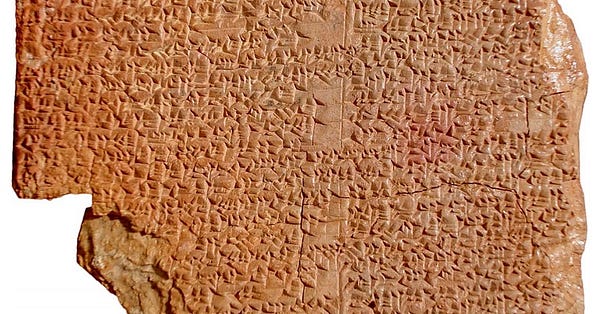Pasts Imperfect (11.25.21)

This week, Evan McDuff discusses ancient and modern food history. Next, we look at what the ancient Greeks can teach us about returning home, the continued debate over the Parthenon marbles, implicit bias in library cataloguing, graffiti in Ancient Egypt and Sudan, myths surrounding the first Thanksgiving, and more…
We all eat. Food keeps us alive. And yet, there is more to food than just sustenance. The annual American feast of Thanksgiving is a yearly reminder that food carries a significant cultural weight and can be intrinsically linked to one’s identity.
In English, terms like ‘Chinese,’ ‘Jamaican,’ and ‘Greek’ can be used interchangeably to describe people or styles of food associated with those people. But as Xiran Jay Zhao points out in her video essay "Why American Chinese Food Deserves Respect...(And Why the MSG Fear is a Hoax)," such terms overgeneralize and often stereotype. She characterizes American Chinese food, for instance, as"just one more branch of Chinese cuisine, which is not a monolith and is always evolving." This is true of regional, local, and group-specific branches of many modern cuisines, each bearing their own signature dishes, flavor profiles, histories, consumers, and subsequent identities. And yet we rarely apply such a nuanced understanding of the multifarious links between food and identity to ancient Roman cuisine.
The literary record from antiquity has provided us with invaluable information about Roman culinary culture. Many of our conceptions about Roman cuisine come from the recipes of Apicius, the dietary advice of Cato, or the scenes described from the banquet of Trimalchio. These documents often represent food ways of the upper echelons of Roman society, and likely only represent the cuisine of Rome and the Italic peninsula. What would American cuisine look like if we viewed it only from the perspective of The Great Gatsby?
These historic documents do not speak to the food habits of most Romans, especially those living outside the Italian peninsula. To compensate, scholars have turned to archaeology to learn about what your average Roman might have eaten. Roman settlements destroyed in the eruption of Vesuvius in 79 C.E. have yielded significant information about Roman cuisine. Recent investigations of a popina in Pompeii found that snails, duck, fish, pig, and goat were served to patrons in a singular entrée. Meanwhile, a recent isotopic study on remains found in Herculaneum indicate gender played a significant role in the availability of dietary proteins. While all these discoveries have helped us diversify our understanding of non-elite cuisine, Naples is a small area in a vast and diverse empire.
If modern cuisine is multiplicious with variations indicative of different regions and people, is it not likely this is true of the Roman world, too? Recent scholarship has shifted focus to specific provinces to fully appreciate the full scope of Roman cuisine. Different regions which had been subsumed into a greater Roman colonial context, such as Gallia and Britannia, seem to have created unique cuisines incorporating elements of both their pre-Roman foodways and greater colonial cuisine. Religious studies and economic histories also provide a better understanding of food in the Mediterranean. Jordan Rosenblum looks at food and identity through Jewish dietary restrictions, whereas studies of the Indian Ocean trade have helped us geolocate the use of imported spices. As scholars continue to explore the interaction of local and imperial foodways, the mosaic of regionally specific cuisines and associated identities throughout the Roman Empire are becoming more visible.
If you are interested in learning more about ancient food or Roman cuisine, check out these handy sources:
Barosiewicz, László. "Zooarchaeology." Encyclopedia of Global Archaeology, 2014.
Belasco, Warren. Food: Key Concepts. Berg Publishers, 2008.
Cappers, Rene. Roman Foodprints at Berenike: Archaeobotanical Evidence of Subsistence and Trade in the Eastern Desert of Egypt. Cotsen Institute of Archeology Press, 2006.
Curry, Andrew. "Philistines had a taste for far-flung foods, fossilized tooth plaque reveals." National Geographic. Dec. 21, 2020.
Dalby, Andrew. Food in the Ancient World from A to Z. Routledge, 2003.
Dalby, Andrew and Sally Granger. The Classical Cookbook: Revised Addition. Getty Publications, 2012.
Donahue, John. Food and Drink in Antiquity: Readings from the Graeco-Roman World. Bloomsbury Academic, 2015.
Erdkamp, Paul and Claire Holleran. The Routledge handbook of diet and nutrition in the Roman world. Routledge, 2019.
Fuller, Dorian Q. and Leilani Lucus. "Archaeobotany." Encyclopedia of Global Archaeology, 2014.
Gowers, Emily. The Loaded Table: Representations of Food in Roman Literature. Clarendon, 1997.
Grant, Mark. Roman Cookery: Ancient Recipes for Modern Kitchens. Interlink Publishing, 2008.
McDuff, Evan and Joel Christensen. "Pour Some Pepper on Me: The King of Spices in Greece and Rome." Eidolon. Feb. 19, 2019.
Robinson, Dana. Food, Virtue, and the Shaping of Early Christianity. Cambridge University Press, 2020.
Scheidel, Walter (ed.) The Science of Roman History: Biology, Climate, and the Future of the Past. Princeton University Press, 2018.
Tykot, Robert. "Bone Chemistry and Ancient Diet." Encyclopedia of Global Archaeology, 2014.
Wilke, Carolyn. “What did ancient people eat? Scientists find new clues in old pottery." Knowable Magazine, July 21, 2021.


Seen on the Web
In her column at The Daily Beast, Candida Moss speaks to Joel Christensen about how the ancient Greeks can help us to grapple with loss, homecoming, nostalgia, and giving thanks this holiday season.
In his recently published book The Many-Minded Man: The "Odyssey," Psychology, and the Therapy of Epic, Joel Christensen, a professor of classical studies at Brandeis University, explores what he calls the “complexity” of returning home. “The Odyssey,” he told me “Is an epic of survival: it asks us to contemplate the costs of returning home for ourselves and others and walks us through the very difficult challenges of reconciling who we are with who we were and who we think we are with who other people see.”
At Hyperallergic, librarian Fuchsia Hart discusses the fact that libraries—like museums—are not neutral.
One of the first examples that struck me was the way that ethnographic studies of Afghanistan are classified. Works on “Pushtuns” can be classified under the shelfmark DS354.58. “Other elements in the population” in Afghanistan, however, are classified under the separate shelfmark DS354.6: “Tajiks,” for example, as DS354.6.T35; while “Hazāras” come under DS354.6.H3. These shelfmarks implicitly create a hierarchy of the knowledge associated with these peoples and, therefore, by extension, of the peoples themselves.

In LARB, Kyle Harper responds to Monica Green’s Pasts Imperfect Review of Plagues Upon the Earth: Disease and the Course of Human History (October 18, 2021).
Over at The Guardian, columnist Simon Jenkins argues that advances in technology such as 3D printing means there are no more excuses in terms of returning the Parthenon marbles.
This debate has been further transformed by developments in replication. Computerised 3D printing and etching pioneered in Italy and at Oxford’s Institute for Digital Archaeology can now recreate with microscopic accuracy ancient buildings and statues, even using the original stone. There are plans to “reprint” Palmyra’s Temple of Baal, destroyed by Islamic State in 2015, and replicate monuments tragically lost in Mosul and Nimrud.
Until December 2, 2021, the Bodleian Libraries are taking applications for their new Afghan Scholars Programme. They note that “those eligible will likely be academics in any field or professionals in the fields of education, heritage and culture. A doctoral degree is not required. The applicant must propose a project of research which can benefit from use of the collections of the Bodleian Libraries. These collections are extensive and include both digital and physical materials.”
At Smithsonian Magazine, the myths of the first Thanksgiving are addressed via historian David Silverman’s new book This Land Is Their Land: The Wampanoag Indians, Plymouth Colony, and the Troubled History of Thanksgiving. As Silverman notes, “If we're taught to cut through colonial rhetoric we'll be better positioned to cut through modern colonial and imperial rhetoric.”
Lectures and Conferences
The conference “Making and Experiencing Graffiti in Ancient and Late Antique Egypt and Sudan” organised by Julia Hamilton is on from December 15-17, 2021, 10.30am–6.30pm (GMT+1). It is online (via Zoom). The public webinar registration is here.


At the University of Pennsylvania library from December 2-3, 2021, there is a conference on the ethics of collecting. Register here.


New Online Journal Issues curated by @YaleClassicsLib
Verbum Vitae Vol. 39, No. 3 (2021) #openaccess Greek Philosophy and Hellenization in the Bible and Christian Theology
Revista de Estudios Clásicos Vol. 50 (2021) #openaccess
Comitatus Vol. 52 (2021) NB: “Thinking with Space: Locating Distributed Cognition in the Eleventh-Century Monastery of Cluny” by Curtis Rager
Shedet Vol. 7 (2020) #openaccess NB: “The Column of Cleopatra III and Ptolemy IX from the Kom Ombo in the Gem (45481)” by Ali Abdelhalim Ali
Atlantís - review Vol. 42 (2021) #openaccess
Circe de clásicos y modernos Vol. 25 No. 2 (2021) #openaccess Memoria, verdad y justicia en el pensamiento greco-romano: debates y proyecciones
Arabian Archaeology and Epigraphy Vol. 32, Suppl. 1 (Nov. 2021) NB: “Sabaeans on the Somali coast”
Vigiliae Christianae Vol. 75, No. 5 (2021) NB: “On an Alleged Senatus Consultum against the Christians” by Mattias Gassman
OTIUM Vol. 10 (2021) #openaccess Culture contact in Western Mediterranean Sea during the Roman age. Pottery as marker between traffics and local production
History of Humanities Vol. 6, No. 2 (Fall 2021) Theme: Decentralizing the History of the Humanities; Forum: The Circulation of Knowledge and the History of Humanities.
Pitches
The Public Books section "Antiquities" continues to take pitches for articles to be published in early 2022. You can also pitch to our “Pasts Imperfect” column at the LA Review of Books using this form. Thanks for reading!







